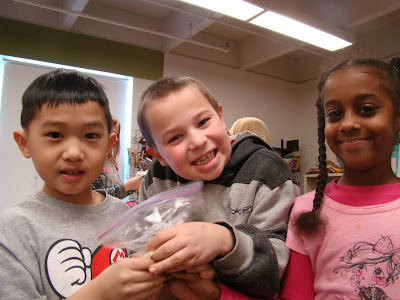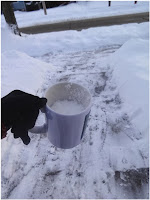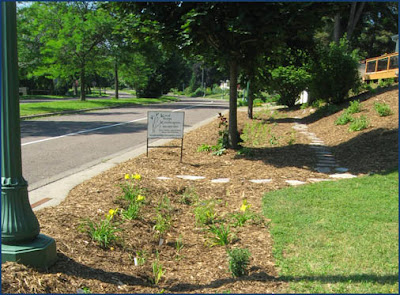| French Immersion students separate seeds from hulls in preparation for seed stratifying. |
When days seem so dark, don’t despair. The hope for the future rests in the säd. No, don’t give in to the gloom of winter in Minnesota. Säd is just Swedish for “seed.” For a few days in mid December and early January, when the days start slowly growing longer, I like to heed the call of the wild seed and head to schools to conjure spring. After all, in the nature business there is no idleness. Believe it or not, in the midst of icy January, the work at hand is encouraging seeds to sprout. Not right away of course, but in due time. In the horticulture or greenhouse business this is called seed stratification.
I tell kids that to “stratify” means to layer. According to Wikipedia, this word can be traced back to at least 1664 when in sylvan culture (forestry) seeds from trees were artificially exposed to cold-moist conditions between layers of soil or peat to encourage future germination in spring.
Sean Uslabar from Ramsey County Corrections first introduced me to seed stratifying at the Ramsey County Nursery back in 2001. Each year Sean and his crew in South Maplewood start seeds in winter and grow thousands of native plants for our District restoration projects and others around the county. Since then I have shared the skills and taught hundreds of kids how to pre-treat seeds to simulate natural winter conditions to have plants mature enough to plant outside in the spring for our rain gardens, restoration sites and native gardens. Master Gardeners who help us in the classroom tell me this is their favorite activity of the year. I think perhaps this is because it helps us face the long, cold dark winter with more than a bit of hope lurking in our midst. And maybe even a little humor!
 |
| Andy Holewa, and many other Ramsey County Master Gardeners, assist classes with stratifying seeds in the District. "Now that I have your attention, let's get down to business." |
For schoolroom classes around the District, this seed preparation process actually begins in the late fall when seeds are collected at demonstration garden sites in school yards or other locations. Students research information about the plants the seeds come from, study the seeds under magnification, draw pictures of them and then clean and separate the seeds from stems, pods and leaves.
How do you stratify seeds?
In the cold-moist stratification process, the seeds are mixed with a small amount of vermiculite and moistened in a ratio roughly of 3 times the amount of vermiculite to volume of seeds, then refrigerated in a plastic bag for about two months. Vermiculite is a naturally occurring mineral that is mined and processed into a puffy, lightweight granule and mixed with soil to improve aeration and drainage. It helps keep the seeds moist while in the fridge. During this cold exposure (between 1 and 3 degrees C, not freezing) many seed species undergo an embryonic dormancy phase, and generally will not sprout until this rest period is broken by exposing them to heat and light.
 |
| Kris Baird, a Ramsey County Master Gardener helps students add moisture to the mixture of vermiculite and seeds. |
To fine-tune the details and lengths for this stratification process for plants native to this area, Prairie Moon’s website is a good source of information. www.prairiemoon.com Just click on the plant you want to know about and you’ll see a germination code that indicates the type of treatment needed and the recommended length of stratification for each species.
Abscisic Acid – Protection from the cold, drought and other scary things
So what’s going on inside the seed to prepare for germination? The secret lies in a plant hormone called abscisic acid (ABA). When most schools in the state were closed in early January, I had a group of 17 kindergarteners and their siblings at Children’s Discovery Academy in Little Canada sitting in rapt attention while I drew a diagram explaining the role of abscisic acid in seed germination. It’s a fascinating story. Unlike animals, plants cannot flee from potentially harmful conditions like
 |
| Abscisic acid helps a seed determine when to germinate. |
- drought
- freezing
- exposure to salt water or salinated soil
The plant hormone abscisic acid (ABA) is a major player in helping a plant adapt to stress. When water in soil diminishes, ABA is produced in a plant’s roots, triggering it to grow further into the ground to seek more water. Then ABA moves to the plant’s leaves where it causes guard cells and stomata to shrink to keep the plant from drying up. Abscisic acid also keeps buds from sprouting prematurely during warm spells in winter. If a plant sprouted early then it would face its demise when the temperatures drop back down to below freezing. Present in the embryo of a seed, abscisic acid enforces dormancy. It gradually breaks down over winter and when it has become depleted, this is a signal that germination can proceed. There’s still a lot that scientists don’t understand about ABA, but research indicates that the ratio of ABA to gibberellins (plant growth hormones that stimulate shoot elongation, seed germination, and fruit and flower maturation) may determine germination. There’s a lot of intensive research going on these days about ABA.
Scarification – a method for getting legume seeds to germinate
There is another approach we use to prepare some seeds for germination. It’s called scarification which means “scoring” or “nicking” to treat your seeds. We do this method with native legume seeds that we want to germinate such as leadplant, blue indigo or purple or white prairie clover. In that approach we use a little light weight sand paper and rub the seed gently to loosen the seed coat. This simulates what might happen when an animal or bird eats a seed and the seed coat is broken down in their digestive tract by acids.
 |
| Shake off the winter blues! |




.jpg)























